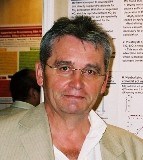Day 2 :
Keynote Forum
Erich Joseph Hums
Consulting Environmental Catalysis, Germany
Keynote: In-situ ultrasonic measurements: A powerful tool to follow the synthesis of zeolites from coal fly ash
Time : 10:00-10:25

Biography:
Hums studied in Berlin, Germany both chemical engineering and chemistry. He has completed his PhD at the University in Bayreuth, Germany. He was consulting technical innovations, support to R&D, patent/ license strategy and pioneering the development of the so-called plate-type catalyst for NOx abatement at the Siemens company. He was lecturing at the University Halle-Wittenberg/Germany. Thereafter he started consulting with companies and universities and serving as an editorial board member of Applied Catalysis B Environmental. He has been instrumental in assisting to achieve industrial collaboration in the emerging science area in South Africa on the fly ash side for UWC/ESKOM. He has published numerous patents, papers and articles.
Abstract:
Theory of crystal growth in the hydrothermal synthesis of zeolites is provided by a great number of mechanistic aspects and modelling studies. In this context in-situ ultrasonic measurements as a real-time, in-situ diagnostic tool is able to monitor changes in the synthesis including incubation and crystallization period in both the liquid and solid phase. It could be shown that diagnostic ultrasound can be used as a tool to calculate kinetic data but also to settle ex-situ techniques, such as XRD, ICP and SEM at predicted times to complement the results of the kinetic study, in our case synthesizing zeolites from fly ash. Class F coal fly ash for our studies was supplied by ESKOM as basis to scale up laboratory results. Although the used ultrasound technology is not a structure-sensitive method of analysis, important information can be obtained from the results concerning the start, course and end of crystallization, which was proven not only at laboratory scale. Reaction rate, reaction order, and activation energy for the crystallization from clear solution were calculated on the basis of ultrasound signal data recorded at different crystallization temperatures. On the basis of measured data it can be detected if there are germs acting in the system to favour competing crystal growth. It should be mentioned that the access to the period of first crystal growth is far more accurate than other techniques demonstrating experimental handicaps.
Keynote Forum
Zulkhair Mansurov
Institute of Combustion Problems, Kazakhstan
Keynote: Processing of heavy oils and oil sands
Time : 10:25-10:50

Biography:
Zulkhair Mansurov is a General Director of the Institute of Combustion Problems of the ministry of Education and Science of the Republic of Kazakhstan, prominent scientist of Kazakhstan; Doctor of Chemistry; Professor; IHEAS Academician; Laureate of the State Prize of the Republic of Kazakhstan and of the Prize named after K. Satpayev.rnIn 1974-1987, Professor Zulkhair Mansurov worked as a junior and senior researcher, and Head of the Laboratory of Physicochemical Methods of Research at S.M.Kirov Kazakh State University. In 1981, he was the first among scientists in Kazakhstan to become a research fellow at the UCL (UK). In 1990, he defended his doctoral thesis at the Institute of Structural Macrokinetics, USSR AS. From 1992 to 2010, he served as Vice President for Research and First Vice-rector of the al-Farabi KazNU.rnProfessor Zulkhair Mansurov is a Chairman of «Combustion and Plasma Chemistry» and «Physics and Chemistry of Carbon Materials» International Symposiums, Chief Editor of «Eurasian Chemico-Technological Journal» and «Combustion and Plasma Chemistry» Journals.rnIn 2004, for services to Kazakhstan Professor Zulkhair Mansurov was awarded «Kurmet» Order.rnUnder Z. Mansurov’s peer supervision, eight Doctors, 38 Masters and eight PhD theses were defended. He is the author of over 670 scientific papers, 6 monographs, 5 textbooks and 21 copyright certificates of the USSR and Kazakhstani patents.rn
Abstract:
One of the most important achievements of recent years is the creation the technology for extraction of “heavy” oil from oil sands (OS) that is intensively developing on Canada. rnHuge deposits of OSof Republic of Kazakhstan which are characterized by content of organic part that ranges from 9 to 95% according to type and depth of each deposit are a prime candidate as an alternative source of hydrocarbons.rnIt is notable that we can obtain organic products with various physical and chemical properties depending on the method of processing of OS.rnIn connection with the above, in the Laboratory of Oxidation Processes of Hydrocarbon raw of Institute of Combustion Problems (ICP) the development of following main directions of processing of OS in order to produce commercial oil products is carried:rn• Extraction of organic part of OS of Kazakhstan deposits using different organic solvents with subsequent oxidizing it to bitumen, that is used for road construction;rn• Thermal processing of OS of Kazakhstan deposits with obtaining of synthetic oils as well as hydrophobic mineral part;rn• Ultrasonic method for separation of organic and mineral parts of OS using solutions of alkaline metals, serving as surfactants;rnAlong with development of methods of OS processing a great attention is paid to improve the physic & chemical characteristics of road bitumen by creation of its composite with rubber crumb, as well as a problem of recycling of rubber pollutants and wastes is solved.rnAn important aspect of ICP research is ecology of oil and gas industry. It is carried research in area of bio-remediation of oil-contaminated soils using bacteria.rn
- Track 3: Petroleum Geology
Track 4: Renewable Energy & Feedstock
Track 5: Environmental & Pollution Issues
Track 6: Filtration & Separation

Chair
Peter Wasserscheid
Friedrich-Alexander-Universität Erlangen-Nürnber, Germany

Co-Chair
Rakhi Mehta
Sarvajanik College of Engineering and Technology, India
Session Introduction
Olga Vladimirovna Zaitceva
Gubkin Russian State Oil and Gas University, Russia
Title: The structural changes of asphaltenes and metalloporphyrins during hydroconversion
Time : 11:05-11:25

Biography:
O V Zaitceva has graduated from Gubkin Russian State University of Oil and Gas with Master’s degree in Chemical Engineering in 2014. Currently, she is a Researcher at TIPS RAS. Her basic scientific interests include development of catalytic processes, hydro-processing of heavy oil and oil residues, modern techniques of the analysis of composition and structure of oil components (spectroscopy, mass spectrometry, chromatography), methods of study physical-chemical properties, colloid-dispersed properties of oil and petroleum products, macromolecular compounds of oil – asphaltenes and resins.
Abstract:
One of the major problems in the deep processing of heavy petroleum feedstock is the high impurity content such as sulfur, nitrogen, vanadium and nickel, concentrated in asphaltene fractions. The solution of this problem most effectively implemented in the hydro-conversion process in the presence of a nano-sized catalyst particles that are synthesized in situ in the reaction environment. The influence of hydro-conversion conditions on the character of changes of molecular and colloidal structures asphaltenes and distribution of metals in hydro-conversion products has been studied. In a previous work, it was noted that the molecular structure of asphaltenes depending on conditions of the process varies in a discrete manner, passing through a step of Transitional State (TS), in which system is the most susceptible to the action of external factor. Investigations of changes in surface morphology asphaltenes during hydro-conversion confirm the main features of the structural transformations of asphaltene molecules depending on the temperature and the number stages of conversions of asphaltenes in the reaction zone. It is shown that the qualitative rearrangement of the molecular structure of asphaltenes by passing through the TS, where the system is most active, leads to qualitative changes in the surface morphology of the asphaltenes and to a change of colloid-chemical structure of the system. Thus, hydro-conversion parameter intervals, corresponding to the TS, are the most favorable in terms of regulation of structural transformations of macromolecular components and increasing level of conversion with low coke formation.
Ali Garrouch
Kuwait University, Kuwait
Title: Automating sandstone acidizing using a rule-based system
Time : 11:25-11:45

Biography:
Ali Garrouch is from Kuwait University, Kuwait
Abstract:
An expert system for automating sandstone acidizing has been developed in this study. The rule-based system is damage type specific, and includes guidelines that account for the mineralogical makeup of the rock as well as the acid-crude interaction. The guidelines, presented in a form of decision trees, include considerations for the presence of acid-sensitive minerals such as zeolites, chlorite, kaolonite, and feldspars, and their distribution in the rock matrix and in the pore space. In addition to the mud acids, and clay acids traditionally used for stimulating sandstones, the expert system recommendations are supported with novel phosphonic acids and acid-chelant blends that are tolerant to temperature, calcite and zeolite presence, presence of chlorite and feldspars. Two delivery methods are used for running the acidizing expert system. The first one is Java Applet Delivery for which a Java application is encapsulated in the HTML code. This method is appropriate for standalone applications. The second delivery method is through Servlet Runtime, which enables running the system as a web application, remotely accessed via the internet. The acidizing expert system has been validated against a large number of field cases spanning the Middle East, and the Niger Delta region in Africa. In each of these cases, the expert system yields an optimal acid job design, along with recommended acid volumes, pre- and post-flushes that are in perfect agreement with successful field results. This expert system will aid engineers avoid pitfalls of the perplexing sandstone acidizing.
Muktar Bashir
Aston University, UK
Title: Modelling of steam gasification of char in a circulating fluidised bed
Time : 11:45-12:05

Biography:
Muktar Bashir is a Ph.D. candidate from Aston University in the European Bioenergy Research Institute Birmingham, United kingdom . He holds a M.Eng degree in chemical engineering from University College London. His research interests are computational fluid dynamics modelling of solar and bioenergy processes. He is currently working on char gasification in a circulating fluidised bed.
Abstract:
Biomass is a renewable source of energy with huge potential to replace or supplement conventional fosil fuels. Biomass gasification is a thermal conversion process to produce fuel or chemicals in the presence of a gasifying medium, mainly air, steam or air/steam mixture. The main challengies in this process is the presence of tar (heavy hydrocarbons) in the product gas, especially at low temperatures. The tar can be thermally cracked at high temperature (>1000 ºC) or catalytically reformed at lower temperature to produce a high quality fuel gas. Biochar, which is a pyroduct from biomass pyrolyis, has been reported to contribute to catalytic cracking of the tar in the presence of steam and carbon dioxide. In this study, steam gasification of biochar has been theoretically incvestigated to predict the product gas quality and to better undestand the extent of tar cracking in the presnece of biochar. The gasification was simulated in a circulating fluidised beds using a three-dimensional computational fluid dynamics (CFD) model based on two-fluid flow (Eulerian-Eulerian) approach and solved using the commeroial software FLUENT. The devolatilisation and heterogeneous gasification reactions have been implemented in FLUENT using in-house developed user-defined function (UDF). To allow for compartive analysis, the simulation was carried out with and without the inclusion of the tar reforming reactions. It has been found that the tar can be significantly reduced when taking into consideration the biochar catalytic effect, even at a reactor temperatuure well below the recommnded range for standard biomass gasification.
Clifford Lipscomb
Greenfield Advisors LLC, USA
Title: Real and perceived risks in communities near unconventional shale gas/oil activities
Time : 12:05-12:25

Biography:
Clifford Lipscomb is the Director of Economic Research at Greenfield Advisors,a Chartered Valuation Surveyor, and has more than 18 years of experience in economic analysis, statistical analysis, consulting, and teaching.He holds baccalaureate degrees in Economics and Sociology from Berry College as well as a PhD in Public Policy from the Georgia Institute of Technology. He serves as an Associate Editor of the Journal of Real Estate Literature. Dr. Lipscomb won the 2014International Association of Assessing Officers’ Bernard L. Barnard Outstanding Technical Essay Award. He is currently a Visiting Scholar at the Federal Reserve Bank of Atlanta.
Abstract:
How unconventional shale activities affecta community can be viewed in terms of perceptions – perceptions of property owners, perceptions of local government officials, perceptions of state officials, and perceptions of firms performing unconventional shale activities. Companies involved in fracking, for example,need to understand how it is perceived by various constituencies (potentially affected property owners, thegreater public, local and state governments) and how those perceptions shape policy and economics. Proactive fracking companiescan identify those perceptions from various stakeholders and work to alleviate concerns of residents near the proposed fracking site and respond to any objections from local or state governments. Also, socio-demographic changes often accompany unconventional shale activities; these may include housing shortages, job re-training, and changes from more rural to more industrial land uses. Firms involved in unconventional shale activities should proactively raise awareness of the operations and dispelling any rumors and myths. Finally, if issues do arise, companies should already have a plan to deal with them that includes communication with the affected community. Open communication lines with residents and government entities are the key in maintaining a positive perception of both the firms involved and the industry as a whole.
Ali Shaeri
REF/NIOEC, Iran
Title: Evaluation of the causes of increasing the pressure drop of fixed bed reactor RCD unit
Time : 12:25-12:45

Biography:
Ali Shaeri is from REF/NIOEC, Iran
Abstract:
The unit of RCD (Reduced CRUDE DESULFURIZATION) was applied for decreasing of Sulfur, CCR (coradson carbon residue), metals of heavy feeds AR (Atmospheric Residue) and VR (Vacuum Residue), and prepared the feed of RFCC unit. The unit includes the following parts: Feed Pretreating (Filter) Section Reactor Section Fractionator Section Make-up Hydrogen Compression Section
Rakhi Mehta
Sarvajanik College of Engineering and Technology, India
Title: Nanofuels: Preparation, stabilization and combustion
Time : 13:30-13:50

Biography:
Rakhi Mehta has completed her PhD at the age of 33 years from Chemical Engineering Department, Sardar Vallabhbhai National Institute of Technology, Surat. She is Head of Chemical Engineering Department at Sarvajanik College of Engineering & Tech., Surat and in the field of Research since last 6 years. She has published 7 papers in reputed International journals such as Fuel, International Journal of Hydrogen Energy, Industrial & Engineering Chemistry Research, Applied Nanoscience, Petroleum Science & Technology to name a few. She has been serving as a Technical advisor on the board of many Chemical Industries.
Abstract:
Nanofuels are suspensions of pure energetic nanomaterials in a liquid fuel that act as a potential energy carrier and release a large amount of heat when being oxidized. Energetic metallic additives offer high enthalpy of combustion, facilitating transportation of more payloads per unit fuel volume. Such mixtures have been reported to show advantages, such as increased energy density, high burn rates and enhanced energy release than the base fuel. But the physical stability of fuels containing nano size energetic additives is a major concern, hence special preparation techniques are required to produce nanofuels with high suspension stability and uniform nanoparticle distribution in continuous liquid phase. Current work discusses the formulation of nanofuels by stabilizing nano metallic particles in petrodiesel. Nanoparticles were stabilized by ultrasonication and addition of surfactant Span 80 (0.1wt %). Diesel fuel containing nano-energetic additives (n-Fe, n-Al and n-B) showed stability for 8, 18 and 24 hours respectively. Suspension stabilities of nanofuels were verified by spectrophotometer plots and backscattering profiles. Measured calorific values showed an increment of 12%, 7% and 2% respectively on combusting diesel doped with 1% of n-Al, n-Fe and n-B. Compression Ignition engine performance showed reduced specific fuel consumption, peak cylinder pressures and CO emissions however brake thermal efficiency and NOx increased. Size analysis of soot produced was carried out using Dynamic Light Scattering (DLS) which supported the visual inspection by SEM microphotographs.
Feridun Demir
OsmaniyeKorkut Ata University, Turkey
Title: Numerical prediction of the reaction rate constant of chlorine disinfection process at a wastewater treatment plant. Experimental model validation and simulation studies
Time : 13:50-14:10

Biography:
Feridun Demir obtained his Ph.D. degree from the Department of Chemical Engineering at the University of Florida, and is currently a Professor of Chemical Engineering at Osmaniye Korkut Ata University in Osmaniye, Turkey.
Abstract:
Chlorine disinfection of wastewater was investigated to estimate the reaction rate constant of the disinfection process at a wastewater treatment plant. The kinetic studies of free chlorine with ammonia show the experimental conditions for the determination of the reaction rate constant. Chlorine reactions with wastewater occurred in the contact basin, and they could be characterized by partial differential equations. In addition to the difficulties of the solution of these partial differential equations, the determination of the reaction rate constant of chlorine disinfection is also difficult because of complex reactions with ammonia and the dynamic behavior of wastewater. These vary, depending on the influent ammonia concentration, chlorine dosage, and wastewater content and flow rate. A method of characteristics and an odometric transformation technique were applied to these equations to more easily obtain a solution. The method of characteristics is a mathematical-solution technique that transforms a partial differential equation into an ordinary differential equation. Because the disinfection reaction also has a large and variable time delay, the odometric transformation technique was introduced to eliminate this obstacle. The application of these mathematical solution and transformation techniques converted the dynamics of the system into a constant time-delay model and a set of ordinary differential equations that were feasible for the numerical integration.To validate the model and determine the reaction rate constant by simulation, the resulting equations were coded in Matlab and solved numerically. The validation was performed by the comparison of the simulated response of the developed model with the experimental data using Matlab software packages. The validation criterion was the obtainment of the highest fit (%) for the simulated result. The simulation results revealed that the fit (%) was the highest when the reaction rate constant was 0.0074 h-1.
Maria Sol Rau
Fraunhofer Institute for Chemical Technology ICT, Germany
Title: HT-PEMFC electrocatalystsapplied in desulfurization
Time : 14:10-14:30

Biography:
María Sol Rau studied Chemistry at the Universidad Nacional del Litoral (Argentina) where she received her PhD in 2011. From 2011 to 2012 she worked as a Post-Doc at the Institute of Surface Chemistry and Catalysis from Ulm University (Germany). She is in charge of the electrocatalysis research activities of the Fuel Cell Group at Fraunhofer ICT. She has published more than 10 papers in reputed journals and has attended to several international conferences.
Abstract:
In a hydrogen challenged economy the implementation of a High Temperature Polymer Electrolyte Fuel Cell (HT-PEMFC) directly connected to a reformer is emerging as a promising technology. Several complicated issues of the LT-PEMFC can be avoided by increasing the working temperature up to 200°C. Nevertheless, hydrogen sulfide present in the reformated fuel causes irreversible deactivation of Pt electrocatalyst. For this reason, at Fraunhofer ICT one of our electrochemical research activities is to develop innovative materials that combine high reactivity to the hydrogen oxidation reaction with elevated tolerance to H2S. In this regard, last year a highly active Pt-based bimetallic electrocatalyst which combines both characteristics was found. An additional advantage of this bimetallic material is that the amount of Pt used is significantly reduced in comparison to commercial catalyst. The higher tolerance to H2S was determined to be related with tits enhanced capability to convert H2S in to SO2, detected in the outlet gas by mass spectrometry. This is an interesting aspect to be considered where new desulfurization techniques are being developed. As an extension of the Fuel Cell application, it was noticed that this type of bimetallic material can be used as a solid electrode to catalyze the oxidation of gaseous H2S at 145°C The aim of the current presentation is to introduce the employment of a HT-PEMFC electrocatalyst for electrochemical desulfurization in the petrochemical industry.
Peter Wasserscheid
Friedrich-Alexander-Universität Erlangen-Nürnber, Germany
Title: Hydrogen storage and transport in Liquid Organic Hydrogen Carriers (LOHCs)
Time : 14:30-14:50

Biography:
Peter Wasserscheid is from Friedrich-Alexander-Universität Erlangen-Nürnber, Germany
Abstract:
Hydrogen is often considered a very capable future energy vector. It can be produced from renewable wind or solar power via water electrolysis and has a wide range of potential applications in all important fields of energy supply. The gravimetric storage density of hydrogen is excellent. One kilogram H2 carries 33,3 kWh (LHV) of energy. However, being the chemical element with the lowest density, the volumetric storage density of hydrogen is only 3 Wh/liter at ambient pressure. In existing technical applications hydrogen is therefore either stored as gas under very high pressures (up to 700 bar, called “Compressed Gaseous Hydrogen” or CGH2) or in its liquid state at 253 °C (called “Liquid Hydrogen” or LH2). A very attractive way to store and release hydrogen is in form of “Liquid Organic Hydrogen Carriers” (LOHC) systems. Aromatic molecules, such as e.g. N-ethylcarbazole (NEC) [1] or dibenzyltoluenes [2] can be reversibly hydrogenated and dehydrogenated in order to store and transport hydrogen in form of diesel-like liquids. The presentation introduces shortly the LOHC concept for energy storage and future hydrogen logistics. Afterwards it concentrates on material and process aspects of LOHC hydrogenation and dehydrogenation catalysis covering the full range from studies on the molecular level (XPS-, IR-studies) to demonstrator units. Challenges and optimization potentials will be discussed; novel options (LOHC transfer hydrogenation, hydrogen purification through LOHC hydrogenation/dehydrogenation) will be presented.
Ridha Gharbi
Kuwait Oil Company, Kuwait
Title: A Surfactant/Polymer Flood Potential in a Typical Middle Eastern Reservoir
Time : 14:50-15:10

Biography:
Ridha Gharbi is from Kuwait Oil Company, Kuwait.
Abstract:
An integrated full-field reservoir simulation study has been performed to determine the reservoir management and production strategies in a mature sandstone reservoir. The reservoir is a candidate for an enhanced oil recovery process or otherwise subject to abandonment. Based on its charateristics, the reservoir was found to be most suited for a surfactant/polymer (SP) flood. The study started with a large data gathering and the building of a full-field three-dimensional geological model. Subsequently, a full field simulation model was built and used to history match the water flood. The history match of the water flood emphasizes the areas with remaining high oil saturations, establishes the initial condition of the reservoir for an SP flood, and generates a forecast of reserves for continued water flood operations. A sector model was constructed from the full field model and then used to study different design parameters to maximize the project profitability from the SP flood. An economic model, based on the estimated recovery, residual oil in-place, oil price, and operating costs, has been implemented in order to optimize the project profitability. The study resulted in the selection of surfactant and polymer concentrations and slug size that yielded the best economic returns when applied in this reservoir. The study shows that, in today’s oil prices, urfactant/polymer flood when applied in this reservoir has increased the ultimate oil recovery and provide a significant financial returns.
Gu Tao
Southwest Petroleum University, China
Title: Characterization of the corrosion of oilwell cement exposed to H2S under high-sulfur gas reservoir conditions
Time : 15:10-15:30

Biography:
Gu Tao is from Southwest Petroleum University, China
Abstract:
H2S is an acidic and toxic gas and the corrosion of H2S on oilwell cement is considered to be a great challenge for wellbore integrity and environmental safety in the exploitation of high-sulfur gas reservoir. In our work, an unidirectional sample was designed to simulate the actual downhole condition, and the corrosion performances of oilwell cement exposed to humid H2S gas and H2S-rich brine were investigated using designed unidirectional samples. Compressive strength, microhardness, porosity, gas permeability, SEM, EDS, and XRD analyses were conducted to compare the dissimilarity of H2S attack in two exposure scenarios. The experimental results show that the corrosion degree of cement exposed to humid H2S gas was lower due to a dense gypsum layer formed on the cement surface; this layer inhibited inward penetration of H2S by blocking diffusion. On the contrary, a porous and loose amorphous silica gel section formed on the headspace of brine-exposed cement for dissolution and migration effects of brine, which facilitated the penetration of H2S to the interior of cement. The degradation mechanism of cement and the effects of exposure scenario on cement properties are proposed.
Zhang Ronghu
Hangzhou Institute of Geology, China
Title: The formation mechanism and exploration significance of ultra-deep, lowporosity and tight sandstone reservoirs in Kuqa depression, Tarim basin
Biography:
Zhang Ronghu is from Hangzhou Institute of Geology, China
Abstract:
The cretaceous ultra-deep reservoirs in Kuqa depression of Tarim basin are over 6000 m deep, which have the coefficient of formation fluid pressure greater than 1.6 and the formation temperature higher than 130°C. In these ultra-deep reservoirs, netted-vertical fractures are developed at the density of 3–12 items/m, with average matrix porosity and permeability of 3.8% and 0.128 × 103 μm2, respectively. This set of ultra-deep reservoirs is presently the core area of in Kuqa depression for increasing reserve and production of natural gas. To elucidate the formation mechanism and exploration significance of ultra-deep reservoirs in Kuqa depression, experimental analysis was carried out through a combination of acoustic emission, confocal microscopy, field emission scanning electron microscopy, electron microprobe, and laser carbon and oxygen isotope techniques. Results indicated that the ultra-deep reservoirs experienced two types of typical superposition effect of diagenesis: 1) strong structure extrusion - strong dissolution - moderate buried compaction - moderate cementation in the Keshen zone associated with the development of fracture-dissolved pore reservoirs; and 2) strong structure extrusion - strong dissolution - moderate dissolution - moderate buried compaction - moderate cementation in the Dabei zone associated with the development of fracture - intergranular pore reservoirs. Effective reservoirs were formed mainly through the following mechanisms: In the early-mid stage, long-term shallow burial preserved pores; in the mid-late stage, internal suspended top structure of gypsum-salt rocks restrained vertical compaction; in the late stage, lateral tectonic extrusion formed the seam-net system; and multi-staged dissolution continuously increased pores. The effective reservoirs were controlled by lithofacies, tectonic extrusion and supergene dissolution, with the depth over 8000 m and a thickness generally between 80 and 200 m. Reservoir densification and hydrocarbon filling concurrently occurred and lateral superposition continuously developed, providing favorable conditions for the formation of continuous petroliferous zones, local hydrocarbon
Amanzhan Saginaev
Atyrau Oil and Gas University, Kazakhstan
Title: Calculation of geometric structure, electronic characteristics, vibration frequencies, and -thermodynamic properties of C12H20-C13H22 alkyladamantanes
Time : 09:20-09:40

Biography:
AmanzhanSaginaev – Doctor of chemical sciences, professor. He is employed by Atyrau institute of Oil & Gas for the Ministry of Education and Science of Republic of Kazakhstan, as the head of laboratory of engineering profile “Petrochemistry” and as a professor of department “Chemistry and chemical technology”. Basic scientific areas: chemistry of adamantane and other framework hydrocarbons, petrochemistry and oil refining. He is the author of over more than 170 scientific and methodical and reference publications.
Abstract:
Oil and gas condensates are the main natural source of hydrocarbons of a diamondlike structure – an adamantane and the highest diamondoides. Gas condensates of MaryAnn \"823\" fields of the Gulf of Mexico, for example, contain more than 60 adamantanes and the highest diamondoides, from an adamantane and his alkylderivatives to derivatives of a triamantanes and tetramantane. Tri - and tetramantanes are identified as well in domestic the oils. Alkylderivatives of these frame structures – alkyladamantane and the highest alkyldiamondoides - are of interest not only as components of high-energy hydrocarbonic fuels, for example rocket fuels of the RF-1, RF-2 type, etc., but have also important scientific value as, owing to features of thermodynamic properties of isomers, they can be used for an assessment of extent of catalytic transformations oil and gas condensates under the influence of natural clays and aluminum silicates and \"certification\" of the fuels received on their basis; these hydrocarbons are useful also as initial connections in thin organic and petrochemical synthesis. Because receiving experimental data on relative thermodynamic stability of isomers of the polyderivativesalkyladamantanes and highest alkyldiamondoides meets certain difficulties, including regarding identification and a spatial structure of isomers, in the solution of such questions calculation methods are urged to play very important role. The structure 1,3-dimethyladamantane, trans-1,4-dimethyladamantane,cis-1,4-dimethyladamantane, 1,2-dimethyladamantane,1-ethyladamantane, 2-ethyladamantane of the general formula C12H20 has been studied using and 1,3,5-threemethyladamantane, 1,3,6-threemethyladamantane,cis-1,3,4-threemethyladamantane,trans-1,3,4-threemethyladamantane, 1-methyl-3-ethyladamantane,cis-1-methyl-4-ethyladamantane,trans-1-methyl-3-ethyladamantane, 1,2,6-threemethyladamantane, 1,2,8-threemethyladamantaneof the general formula C13H22 has been studied usingthe Becke–Lee–Yang–Parr (B3LYP) hybrid method for the energy functional of the electron density withthe 6-31G* basis set. Geometric and electronic characteristics of the compounds and their total energy, trans-formation energies, transformation entropies, and normal vibration frequencies have been calculated.
Yan-Ping Chen
National Taiwan University, Taiwan
Title: Measurement for the Dissociation Conditions of Methane and Carbon Dioxide Hydrates in the Presence of Additive Materials
Biography:
Yan-Ping Chen has completed his PhD degree in 1982 from the Department of Chemical Engineering, Rice University, Houston, Texas, USA. He has been teaching at the Department of Chemical Engineering, National Taiwan University from 1982 to the present time. He is a Full Professor since 1988, and has served as the Department Chairman from 1998 to 2001. His research area includes Thermodynamics of Phase Equilibria, Supercritical Fluid Technology, and Gas Hydrate Studies. His recent research results have been published in Fluid Phase Equilibria (Gas Hydrate Studies), and Journal of Supercritical Fluids (Supercritical Fluid Studies).
Abstract:
The target of this study is to find the appropriate materials as additives for the formation or dissociation of methane or carbon dioxide hydrate. These hydrates are used for either natural gas energy sources or for carbon dioxide sequestration. The dissociation conditions for gas hydrates in the presence of additives at various concentrations in aqueous solutions were experimentally measured in this study. These additives include alcohols, cyclic ethers, or cyclic ketones. Hydrate phase dissociation conditions were measured with an apparatus which was operated at high pressure and low temperature conditions. The liquid water-hydrate-vapor (Lw-H-V) three-phase dissociation temperatures and pressures for methane hydrate in the presence of additives were determined by employing the isochoric method. New experimental data were reported within the pressure range from 4 to 15 MPa. It is demonstrated that the addition of certain additives in gas hydrate system shifted the original hydrate phase boundaries to lower pressure and higher temperature. The hydrate stability region was broadened, therefore it has a promotion effect on the formation of gas hydrate. Other additives might show inhibition behavior. These promotion or inhibition effect is also investigated by the possible hydrate structures in cases of various additive materials. The determination of gas hydrate structures is calculated using the Clausius-Clapeyron equation and the experimental measured dissociation temperature and pressure data.
Hassene Affouri
University of Sfax, Tunisia
Title: Organic matter in the Albian, Cenomanian-Turonian and Ypresian petroleum source rocks in central and northern Tunisia
Time : 10:20-10:40

Biography:
Hassene Affouri is from University of Sfax, Tunisia
Abstract:
Total organic carbon (TOC) determination, Rock-Eval pyrolysis, extractable organic matter content (EOM) fractionation, as well as gas chromatography-mass spectrometry (GC-MS) analyses, were carried out on samples from outcrop cross sections of the Albian (Lower Fahdene Formation), Cenomanian-Turonian (Bahloul Formation) and Ypresian (Bou Dabbous Formation) in central and northern Tunisia. At the Albian age organic-rich facies were deposited corresponding to a global ocean anoxic event called \"OAE1b\". In northern Tunisia, the Albian sediments are represented by limestones and marly limestones rich in organic matter (OM) and correspond to the base of the Fahdene Formation (Albian-Cenomanian). In central and northern Tunisia, the Cenomanian-Turonian (C/T) boundary succession is represented by thinly laminated carbonates with some marly beds assigned to the Bahloul Formation. This formation was deposited during a so-called ocean anoxic event 2 (OAE2). The paleogeography of the Lower Eocene (Ypresian) basin in Tunisia was characterized by the deposition of various facies that had been named formations which include the Bou Dabbous Formation. It is one of the four lateral equivalents of the Metlaoui Group and consists of micrite and marls with abundant planktonic foraminifera (Globigerina). The total organic carbon (TOC) values and Rock-Eval analysis showed that these Formations had preserved Type II/III marine and continental organic matter (OM). Locally, TOC values are very high. These values are reliable to the structural framework during the Albian, the C/T and the Ypresian epochs. The Rock-Eval maximum pyrolysis temperature (Tmax) values in the ~ 420-460°C range delineated a general east-west and north-west trend increase in the OM thermal maturity. The disparity in hydrogen index (HI) values was relevant for the discrepancy in the level of OM preservation and maturity among localities and samples. The Albian, C/T and Ypresian OM are rich in biological markers or biomarkers such as alkanes, steranes and terpanes. These were used to assess the degree of thermal maturity and to reconstruct the OM precursors and their deposition environments. The n-alkane distributions, maximizing in the C17 to C20 range, are typical for a marine planktonic origin, whereas pristine/phytane (Pr/Ph) average values in the 1-2 range indicate an oxic to suboxic depositional environment. Pr/n-C17 and Ph/n-C18 ratios values in the 0.38-6.2 and 0.68-3.25 range, respectively, are consistent with other maturity indicators and denote the contribution of specific bacteria to phytol as a precursor of isoprenoids (Pr and Ph). The thermal maturity varies between the late diagenesis to the main-stage of petroleum generation based on the optic and the cis-trans isomerisation of the C29 sterane and the terpane [18ï¡(H)22,29,30-Trisnorneohopane/ (18ï¡(H)22,29,30-Trisnorneohopane + 17ï¡(H)22,29,30-Trisnorhopane) : Ts/(Ts+Tm)] ratios. Furtheremore, these OM are represented by an open marine to estuarine algal facies with a specific bacterial contribution as revealed by the relative abundance of the ï¡ï¡ï¡-20R C27, C28 and C29 steranes and by the abundance of the tricyclic terpanes (T-C21 to T-C29) and the hopane compounds for all the samples. Locally, the good preservation of OM in the Albian facies and in the Bou Dabbous Formation has been evidenced by the good conservation of the C34 and C35 homohopanes compounds and the high abundance of gammacerane in central compared to the northern part of Tunisia. These features are characteristics of a highly bacterial contribution to the organic supply and extremely anoxic deposition environments. Finally, the OM richness in these studied Formations was controlled both by an oxygen minimum zone induced by high productivity and restricted circulation in narrow grabens structures.
Awojoyogbe Bamidele
Federal University of Technology, Nigeria
Title: A mathematical and computational analysis for magnetic susceptibility of ntural reservoir fluids based on Bloch Nmr susceptibility nodel in porous systems

Biography:
Awojoyogbe Bamidele is from Federal University of Technology, Nigeria
Abstract:
It is noted with keen interest that the advancements in instrumentation and software over recent years have led to increased research activities in the application of magnetic susceptibility methods in the hydrocarbon industry. Such interests are basically centred on magnetic susceptibility measurement and their integration with magnetometer and other surface geophysical surveys and with soil magnetic studies accomplished in the laboratory. In spite of the wide utilization of magnetic methods and magnetic susceptibility techniques in geophysical exploration, very limited research data are available on the magnetic susceptibility of natural reservoir fluids (crude oils, formation waters and other reservoir related fluids such as injection and drilling fluids). Also, magnetic susceptibility has not been able to provide sufficient contrast between sand, gravel, clays and other sedimentary rocks. In fact, it has been noted that one of the major challenges in the application of magnetic methods is the isolation of weak magnetic anomalies as a result of low concentrations of the magnetic minerals in sediments. This shows that we need additional contrast sources to confirm the measured magnetic susceptibility of reservoir fluids and the surrounding rock matrix. Fortunately, magnetic resonance offers us an opportunity of relating the magnetic susceptibility to the T1 and T2 relaxation times which are unique to different materials. Therefore, we present a method by which magnetic susceptibility of reservoir rocks and fluids can be related to the observed physical and chemical features via NMR relaxation based on the fundamental Bloch NMR equations. From our single and simple analytical results, we can determine the fluid flow velocity, viscosity for wetting phases, viscosity for non-wetting phases, the interfacial tension between two fluids, the contact angle measured from the side of the wetting phase, permeability, the component of gravity in x direction between fluid displacement and the density difference between displaced and displacing fluids. These parameters will enable us to express the relative magnitude of viscosity or gravity over capillary forces as well as the ratio in viscosities. In addition to the geometrical description of the medium, these parameters fully characterize the displacement in terms of the distributions of the various quantities (such as pore size or permeability) at the various scales and correlation lengths.
Cong-Sheng Bian
Research Institute of Petroleum Exploration & Development, China
Title: Contribution of overall moderate uplift of basin to Coal-bearing tight sand gas accumulation
Biography:
Cong-Sheng Bian is from Research Institute of Petroleum Exploration & Development, China
Abstract:
As an important unconventional gas resource, tight sand gas distributes widely in different petroleum basins. In coal-bearing formations of Upper Triassic in the Sichuan Basin and the Carboniferous and Permian in the Ordos Basin, coal measure strata and tight sandstone constitute widely distributed source-reservoir assemblages, and form the basic conditions for the forming of large tight sand gas fields. Similar to most tight gas basins in North America, the Sichuan Basin and Ordos Basin all experienced overall moderate uplift and denudation in Meso-cenozoic after earlier deep burial. Coal seam adsorption principles reveal and actual sample simulation experiment results show that in the course of formation uplift, pressure drop and desorption occur in coal measure strata, resulting in the discharge of substantial free gases, accounting for 28-42% of total gas expulsion from source rocks; simultaneously, the free gases formerly stored in the pores of coal measure source rocks were also discharged in a large scale due to volumetric expansion resulted from formation uplift and pressure drop. Based on experimental data, the gas totally discharged in the uplift period of Upper Paleozoic in the Ordos Basin and Upper Triassic Xujiahe Fm in the Sichuan Basin is calculated as 3-6×108 m3/km2. Geological evidences for gas accumulation in the uplift period are found in the gas reservoir analysis of the above two basins. Firstly, natural gas discharged in the uplift period has lighter carbon isotope and lower maturity than that formed in the burial period, belongs to the one generated at early stage of source rocks, and is absorbed and stored in coal measure strata. Secondly, physical simulation experiment results under high-temperature and high-salinity inclusions and almost actual geologic conditions confirm that substantial gas infusion and accumulation occured in the uplift period of coal measure strata of the two basins. Diffusive flow infusion is the main mode for gas accumulation in the uplift period, which can reach 56×1012m3 in the uplift period of Xujiahe Fm of the Sichuan Basin, compensates the diffusive loss of gas in the gas reservoirs, and has an important contribution to the formation of large gas fields. The above insight has promoted the gas resourc extent and potential of the coal measure tight sand uplift area; therefore, it needs to reassess the formerly believed unfavorable areas where the the uplift scale is larger, so as to get better resource potential and exploration prospect.
Mohammadali Baghbanzadeh
University of Ottawa, Canada
Title: Enhancement of the structural properties of membranes by hydrophilic nanoparticles for vacuum membrane distillation

Biography:
Mohammadali Baghbanzadeh received his BSc and MSc degrees from the “University of Tehran” in 2009 and “Sharif University of Technology” in 2011, respectively. Then he joined Prof. Lan’s research group as a PhD student at the “University of Ottawa”. He is the recipient of the “Ontario Trillium Scholarship”, one of the most prestigious Canadian scholarships, awarded at uOttawa in 2013. His current research focus is on water desalination by membrane distillation process.
Abstract:
Desalination has been demonstrated to be an appropriate technology in compensating the lack of fresh water in different areas of the world. Among the processes which are used for treating the saline water, membrane-based technologies have been placed on top due to their energy-saving and cost-effective nature. Presently, desalination load is mainly dominated by reverse osmosis (RO), i.e. a pressure driven process which fairly demands large amount of electrical energy and works in harsh operating conditions. Membrane distillation (MD) has been shown to be a serious competitor with RO in obtaining the desalination market owing to its low tendency to fouling and scaling which further results in a simplified pre-treatment process, its ability in processing the high concentration feeds and working in mild operating conditions. Although, huge thermal energy consumption within the process along with the low performance MD membranes have been led to this fact that reaching the fresh water by MD is not economically feasible. One approach in reducing the thermal energy consumption could be the development of high performance MD membranes which works efficient at low temperatures. In other words, MD needs durable membranes which are able to achieve the high flux i.e. that of the MD membranes in typical operating conditions, at low temperatures. To improve the membrane performance and considering the outstanding characteristics of the nanocomposite membranes, in this study, hydrophilic nanomaterials, i.e. CaCO3, CuO, and SiO2 were incorporated in a polyvinylidene fluoride(PVDF) membrane for vacuum membrane distillation (VMD). According to the results, hydrophilic nanoparticles could improve the membrane structure via enlarging the surface pores and increasing the membrane porosity through reducing the thickness of the sponge-like layer, i.e. the major contributor to mass transfer resistance in the membrane. The permeability of the neat PVDF membrane at 27.5 ºC increased by 102.3%, 153.4%, and 2456.0% via using the appropriate amount of CaCO3, CuO, and SiO2 nanoparticles respectively. All the nanocomposite membranes possessed suitable contact angle and liquid entry pressure (LEPw) along with perfect rejection to be employed in desalination by VMD.
Wenzheng Li
PetroChina Hangzhou Research Institute of Geology, China
Title: Genesis and evolution of Lower Cambrian Longwangmiao formation reservoirs, Sichuan Basin, SW China
Biography:
Wenzheng Li is from PetroChina Hangzhou Research Institute of Geology, China
Abstract:
In recent years, the largest integral single gas field of the Lower Cambrian Longwangmiao Formation with proved reserves of 4 403×108 m3 was found in Sichuan Basin, China, and the main production is from Longwangmiao Formation grain dolomite. Based on observation of outcrops, cores and thin sections and analysis of logging data and experiment, the features, main controlling factors, evolution and distribution of the Longwangmiao Formation reservoirs in the Lower Cambrian, Sichuan Basin, are examined carefully and the distribution of favorable reservoirs is predicted. The Longwangmiao Formation reservoirs are grain shoal-dolostone fracture–vug type, made up of residual dolarenite, oolitic dolomite, and crystal dolomite; with vugs and dissolution pores as the main storage spce, residual intergranular pores, intercrystalline pores and fractures as the secondary storage space, these reservoirs have a porosity of 2%~8%, 4.28% on average, and a thickness of 20m~60 m, 36 m on average. Shoal facies and penecontemporaneous dissolution are the main factors controlling the reservoir occurrence. Grain shoal, the basis of reservoir development, controls the phases and distribution of reservoir. Penecontemporaneous dissolution is the key factor affecting the formation of the main reservoir space. In addition, penecontemporaneous dolomitization plays a constructive role in the preservation of the pores formed earlier and generation of micro-fractures in late stage. The reservoirs experienced four evolution stages. The sedimentation and penecontemporaneous dissolution in pore-forming period laid the material basis for reservoir space types and physical property conditions. Supergene karstification and burial dissolution made some contributions to the improvement of reservoir physical properties. Hydrothermal mineral filling and asphalt filling are the main factors making reservoir quality worse. Based on the main controlling factors of the Longwangmiao reservoir, the favorable reservoir zones are ancient high topography areas between Huayingshan Fault and Longquanshan Fault, and breakthroughs are expected to make in the Guangan-Nanchong-Jiange area.
Biography:
Theresa Nganje is from University of Calabar, Nigeria
Abstract:
The sum of concentration of total polycyclic aromatic hydrocarbons in soils collected from the vicinity of spilled fuel from pipeline which carries fuel from jetty to a tank farm were analysed for sixteen priority PAHs using Gas Chromatography – Mass Spectrophotometer (GC - MS). The total PAHs concentrations in the soil ranged from 16.06µg/Kg to 25,547.75 µg/Kg with a mean concentration of 2,906.36 µg/Kg. Sum of PAHs concentration of the seven carcinogenic PAH compounds in soil varied from 0.02 to 97,954 µg/Kg. In terms of compositions of patterns in soil the PAHs were dominated by three and four rings. The distributions pattern show a predominance by low molecular weight compounds. In comparison with sum of concentrations of PAHs in other parts of the world and part of the study area, the total PAHs concentrations in this study were higher than those reported in some urban, semi urban and rural soils in some regions of the world and in the vicinity of some petroleum handling facilities in part of the study area.The ratios Phenanthrene/Anthracene, Fluoranthene/Pyrene, Fluorantine/Fluorantine+Pyrene and Benzo(A)Anthracene / Benzo(A)Anthracene + Chrysene in the soil indicated various sources of PAHs in the area. These sources includes fuel spills, burning of motor tyres and vegetation, vehicle repairs and washing, motor exhaust and fire wood burning from cooking.
